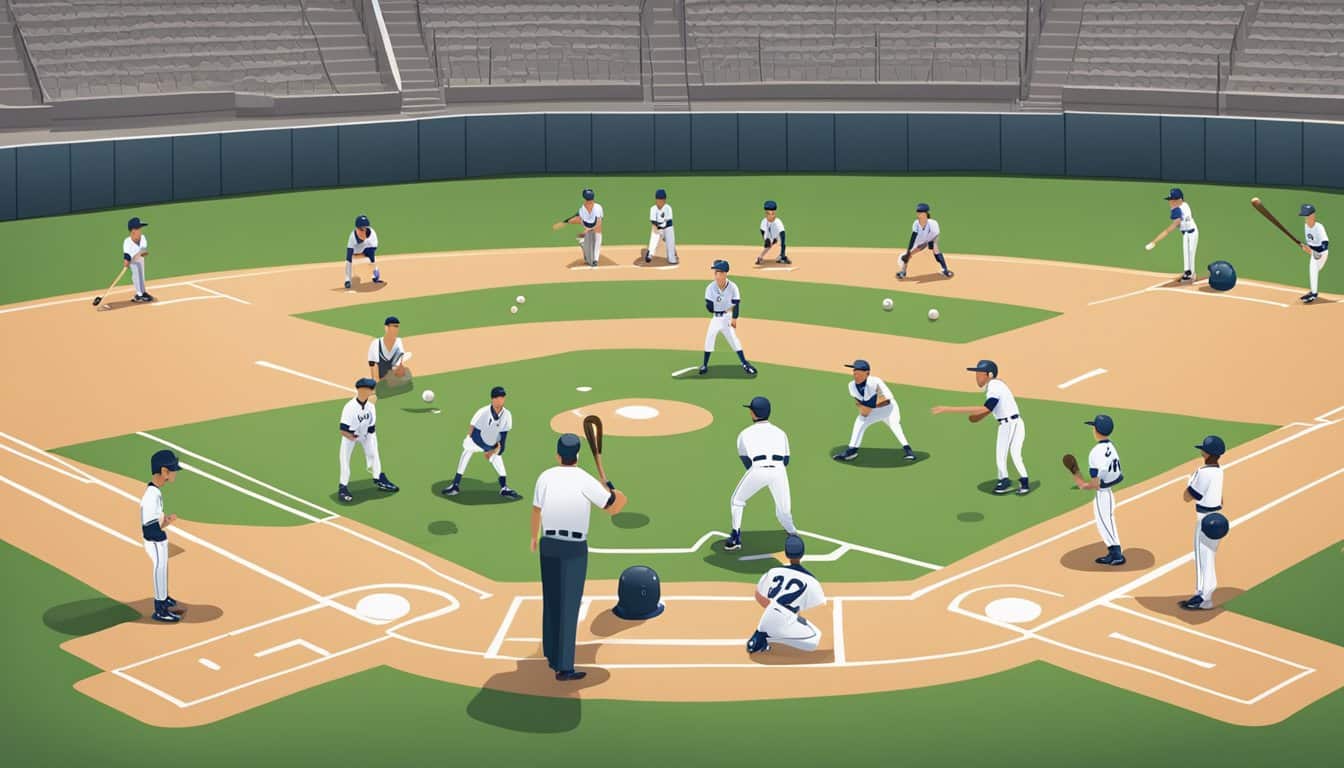In the realm of baseball, mastering the art of hitting is a fundamental skill that distinguishes the good players from the great ones. The batting tee, a simple yet versatile training tool, plays an essential role in developing a hitter’s technique and consistency. When utilized effectively within team drills, a batting tee can provide immediate feedback to batters, allowing them to hone their swings through repetition without the unpredictable variables of live pitching.
Designing team drills that incorporate the batting tee involves a careful understanding of the mechanics of the swing and the goal of each practice session. It requires coaches to be knowledgeable in creating a series of exercises that not only improve the individual player’s form and power but also contribute to the team’s cohesive performance on game day. The right drills focus on developing a strong batting stance, ensuring players are able to respond swiftly and accurately to various pitch locations, and integrating physical conditioning to build strength and agility.
Key Takeaways
- Batting tee drills are crucial for improving swing technique and consistency.
- Effective drills enhance stance, swing mechanics, and overall team performance.
- Customized practice sessions with the tee translate to better results on the field.
Understanding the Basics of Batting Tees
https://www.youtube.com/watch?v=VBGjLcNTbLw&embed=true
A batting tee is a fundamental tool in baseball training, allowing batters to practice their swing independently. They are instrumental for both individual practice and team drills.
Types of Batting Tees
Adjustable Tees: These tees can be altered in height to accommodate players of various sizes, making them versatile for players at different developmental stages.
Stationary Tees: Designed with a fixed height, stationary tees are suitable for players of a similar size or age group where adjustability is not a priority.
Weighted Base Tees: These tees have a weighted base to prevent tipping over during vigorous training sessions.
Tripod Tees: A tripod base offers stability and can absorb errant hits without toppling, offering a consistent practice environment.
Multi-Position Tees: These allow batters to practice hitting outside, middle, and inside pitches by adjusting the position of the ball on the tee.
Selecting the Right Tee for Your Team
-
Durability: A tee should withstand repetitive use, so materials like rubber and heavy-duty plastics are preferable.
-
Stability: A sturdy base is crucial to endure the impact of multiple swings without tipping.
-
Adjustability: A good tee should accommodate players of all sizes. Look for tees with easy height adjustment mechanisms.
-
Portability: Tees that can be disassembled quickly benefit teams that travel or share practice spaces.
When selecting a batting tee for your team, one should consider the team’s age range, skill level, and the frequency of practice sessions. The ideal tee balances durability, stability, adjustability, and portability to match the team’s needs.
Developing a Strong Batting Stance
https://www.youtube.com/watch?v=0QprwQyrX9M&embed=true
The foundation of any successful hitter is a strong and effective batting stance, which provides stability and power. The correct stance serves as the launching point for dynamic and efficient swings.
The Role of Stance in Hitting Mechanics
A batter’s stance is critical because it affects the entirety of their swing mechanics. It dictates the initial position of the lower body, including the feet, legs, and hips, which are essential for generating power. A well-executed stance positions the hitter for optimal balance, vision, and energy transfer during their swing. Consistency in the stance ensures that the swing mechanics can be replicated, leading to improved contact with the ball.
- Feet: They should be shoulder-width apart, offering a balanced base.
- Legs: Slight bend in the knees to facilitate quick movements.
- Hips: Aligned with the feet, allowing for swift hip rotation during the swing.
Foundation Techniques for a Power Stance
To create a power stance, a few key techniques should be focused on:
- Lower Body Alignment: Align the feet with the shoulders to maintain balance and maximize power. The insides of the feet should face the pitcher, creating the foundation of the stance.
- Weight Distribution: Slightly more weight should be on the back leg to allow for a powerful leg drive and hip rotation.
- Flexibility in the Knees: Maintain a slight bend in the knees, facilitating a quick and explosive movement towards the ball.
These techniques promote a stable and powerful base from which the batter can launch an efficacious swing. The correct batting stance is an amalgamation of disciplined posture and an understanding of body mechanics, each contributing to the batter’s overall performance at the plate.
Mechanics of a Powerful Swing
https://www.youtube.com/watch?v=2TPPpeknChE&embed=true
The key to a powerful swing lies in fine-tuning the hitting mechanics to promote muscle memory, ensuring precision through optimal hand-eye coordination, and mastering the complex relationship between swing paths and angles to generate maximum power.
Building Muscle Memory for Swing Consistency
Building muscle memory is crucial for swing consistency. A batter develops this through repetitive practice, focusing on maintaining the same swing mechanics each time. They must concentrate on:
- Stance and Grip: A balanced stance and firm grip are the foundation.
- Load and Stride: The load phase involves the batter coiling in preparation, while the stride is the step towards the pitch.
- Hip Rotation: Power comes from the hips; efficient rotation is essential.
- Contact Point: They should strive to make contact at the same point for consistent hits.
Through repetition, these components become second nature, contributing to a consistent and powerful swing.
Optimizing Hand-Eye Coordination
Optimal hand-eye coordination allows a batter to track and hit the ball successfully. Key practices include:
- Vision Drills: Tracking the ball from the pitcher’s release point.
- Tee Work: Practicing swings on various tee heights and positions.
- Soft Toss: Adjusting to different speeds and angles with a partner tossing balls.
By enhancing their ability to see and react to the pitch, a batter increases their chances of making powerful contact.
Mastering Swing Paths and Angles
The path and angle of the swing have a significant impact on the power and direction of the hit. Critical aspects include:
- Launch Angle: The ideal angle for the bat to meet the ball, affecting the flight of the hit.
- Swing Plane: Aligning the bat’s path with the pitch trajectory for more efficient power transfer.
- Follow-Through: Ensuring a complete follow-through to maximize bat speed and power.
Players can use the batting tee to practice and refine these elements, adjusting their swing to find the optimal paths and angles for their most potent hit.
Advanced Batting Tee Drills
https://www.youtube.com/watch?v=SkLvrOJQQHc&embed=true
Advanced batting tee drills are designed to isolate and improve specific hitting techniques and increase bat speed and power. These drills provide a structured approach for batters looking to take their skills to the next level.
Isolation Drills to Improve Specific Techniques
Isolation drills focus on refining individual aspects of a batter’s swing. For instance:
- Inside Pitch Drilling: The tee is positioned close to the batter’s body, promoting a compact swing and encouraging the hitter to keep their hands inside the ball.
- Opposite Field Hitting: By placing the tee on the outer half of the plate and encouraging a later contact point, batters can improve their ability to drive the ball to the opposite field.
These targeted drills help batters hone their mechanics in a controlled setting, allowing for immediate feedback and adjustment.
Drills for Increasing Bat Speed and Power
To increase a batter’s power and bat speed, specific drills are implemented that require a combination of strength and technique:
- Weighted Bat Training: Swinging a weighted bat before performing regular tee drills can enhance muscle memory and increase bat speed.
- High Tee Drills: Elevating the tee so the ball is at or above shoulder height forces the batter to work on hitting high pitches with power and maintaining a level swing through the zone.
Through repetitive practice, these drills help build the muscle groups and motor patterns necessary for a more powerful and faster swing.
Strategic Practice for Game Situations
https://www.youtube.com/watch?v=avhEgSb8HX0&embed=true
Incorporating batting tee drills that simulate game situations allows players to fine-tune their timing, rhythm, and ability to react under various pitch scenarios. These drills are designed to make practice as game-like as possible by requiring adjustments similar to those needed during actual games.
Drills Focusing on Timing and Rhythm
To achieve optimal timing and rhythm, batters must practice their swing mechanics until they become second nature. Here are some drills:
Quiet Load Drill:
- Purpose: Develop a smooth, rhythmic load without unnecessary movement.
- Setup: Batter assumes stance with the batting tee set up at chest height.
- Execution: On coach’s call, batter makes a controlled stride and initiates the swing.
Tempo Swing Drill:
- Purpose: Enhance consistency in swing tempo.
- Setup: Tee placed in various zones (inside, outside, middle).
- Execution: Batter swings at a consistent speed, focusing on fluidity.
Practicing Hitting in Various Pitch Scenarios
Creating pressure situations during tee practice can prepare players to adapt their hitting approach on the fly:
Inside Pitch Emphasis:
- Goal: Teach hitters to turn on inside pitches and prevent jam shots.
- Drill: Place the tee closer to the batter, simulating an inside pitch.
- Outcome: Hitters should aim to hit the ball to the pull side, clearing the hips efficiently.
Hit and Run Drill:
- Goal: Practice hit and run situations where batters must make contact.
- Drill: Tee is positioned where a typical pitch for a hit and run would be placed.
- Execution: On the coach’s signal, the batter swings with the intent to hit the ball on the ground.
These targeted drills help batters make the necessary adjustments to their swing and approach, thus translating their practice efforts into effective in-game performance.
Enhancing Agility and Reaction Time
https://www.youtube.com/watch?v=x8-eq7RNsaQ&embed=true
Effective training with a batting tee can significantly improve a player’s agility and reaction time, enabling them to respond quickly to various pitches. Incorporating targeted drills can hone a batter’s ability to adjust their swing to the location of the pitch for optimal contact.
Drills to Sharpen Reaction to Different Pitches
To develop a batter’s reaction to different pitches, coaches should design drills that simulate inside and outside pitch scenarios. For example:
- Inside Pitch Drill: Players take stance and react to simulate an inside pitch, focusing on quick hands and turning their hips to avoid getting “jammed.”
- Outside Pitch Drill: Batters work on hitting an outside pitch to the opposite field with an emphasis on timing and extending their arms while maintaining balance.
| Pitch Type | Drill Focus | Player Action |
|---|---|---|
| Inside Pitch | Quick hands, hip turn | Practice swinging with a compact motion to prevent getting jammed. |
| Outside Pitch | Timing, opposite field | Work on driving the ball to the opposite field with extended arms. |
Incorporating rapid pitch recognition techniques and adjusting the tee height and location will train batters to react swiftly and accurately to the ball’s placement.
Agility Training for Responsive Batting
Agility training drills with a batting tee focus on developing a batter’s overall speed and nimbleness at the plate:
- Lateral Movement Drill: They should practice moving laterally to position themselves effectively for various pitch locations, enhancing their range of motion.
- Quick Feet Drill: Emphasizing rapid footwork, players can improve their ability to reposition quickly, allowing for more efficient swings and better adaptation to the pitched ball.
| Agility Drill | Purpose | Player Focus |
|---|---|---|
| Lateral Movement | Enhance range of motion | Practice sidestepping quickly to align with the tee for varied hits. |
| Quick Feet | Improve repositioning | Perform fast footwork exercises to boost overall batting stance. |
Regular agility training can improve a player’s physical response, leading to better performance against different types of pitches and in various batting situations.
Integrating Physical Training and Conditioning
Physical training and conditioning are critical in enhancing a player’s swing power and ensuring consistency in their batting technique. This section explores specific strengthening and flexibility exercises tailored to improve one’s performance at the plate.
Strengthening Drills for Enhanced Swing Power
A robust conditioning regimen focusing on strength is fundamental for increasing swing power. Players should incorporate resistance training with emphasis on the core, legs, and upper body. Some workouts that synergize well with batting tee drills include:
-
Deadlifts: Strengthen the lower back, glutes, and hamstrings; important for a powerful stance and explosive movement.
Repetitions Sets Rest Interval 6-8 3-4 2-3 min -
Medicine Ball Throws: Enhance rotational strength and power; key for effective energy transfer during the swing.
Repetitions Sets Rest Interval 10-12 3 1-2 min
Incorporating plyometrics, such as jump squats and box jumps, will develop explosive strength that translates into a more forceful swing.
Flexibility and Balance Exercises for Better Swings
Flexibility and balance play pivotal roles in achieving an optimal swing path and maintaining control during the swing. These exercises help in creating fluidity in movements and enhancing muscle memory:
-
Dynamic Stretching: Prioritize movements mimicking the swing to improve range of motion and flexibility.
Examples Duration Frequency Torso twists 30 sec Daily Leg swings 30 sec Daily -
Balance Drills: Utilize stability balls or balance boards to challenge and improve balance. Effective balance is critical for maintaining a solid base throughout the swing.
Exercise Sets Duration Single-leg stands 3 30 sec Stability ball squats 3 30 sec
Regular integration of these strength and flexibility workouts into a player’s regimen will significantly enhance performance when combined with skilled use of a batting tee.
Analyzing and Adjusting Player Performance
Effective analysis and adjustment are crucial for consistent improvement. Leveraging feedback and tracking progress serve as the foundation for elevating player performance.
Using Feedback to Make Swing Adjustments
Feedback is vital for identifying flaws and strengths in a player’s swing mechanics. Coaches should observe players during tee drills and provide immediate, specific comments on their technique. For instance, if a player consistently hits too low on the ball, the coach may suggest a change in stance or bat angle. This can be documented as follows:
- Observer’s Note: Low contact point on the ball.
- Adjustment: Raise stance slightly and adjust bat angle upward.
- Expected Outcome: Increased likelihood of hitting the center of the ball.
Player engagement with feedback is equally important. They must understand and apply the given advice during subsequent practice sessions.
Tracking Progress and Setting Goals
Maintaining records of each player’s performance is essential for tracking progress over time and setting achievable goals. Charts or digital apps can be used to document key performance metrics such as swing speed, bat path, and point of contact. Here is an example of a simple tracking table:
| Date | Swing Speed | Bat Path | Point of Contact | Notes |
|---|---|---|---|---|
| 12/21 | 85 mph | Straight | Center | Improved from last session |
| 12/22 | 87 mph | Slight curve | Upper third | Adjust stance |
Specific goals should be SMART: Specific, Measurable, Achievable, Relevant, and Timely. For a batter aiming to enhance power, a goal might be to increase swing speed by 5 mph within the next month, ensuring the goal is clear and quantifiable. Regularly comparing current performance against set goals helps players see their improvements and areas needing further work.
Team Building and Competitive Drills
Incorporating team building and competitive elements into baseball batting practice can enhance a team’s performance and camaraderie. Drills designed for these purposes encourage players to push each other to improve while fostering a supportive team environment.
https://www.youtube.com/watch?v=1MAMWCYKb5g&embed=true
Creating a Collaborative Team Environment
Designing batting drills around team goals can reinforce the concept that every player’s improvement contributes to the team’s overall success. Coaches should focus on activities that promote collaboration, such as peer feedback sessions during batting tee work where players observe and offer constructive feedback on each other’s technique.
- Team circuit drills involve smaller groups rotating through stations, which could include hitting off tees, bunting practice, and strength exercises.
- Consistent, positive reinforcement from coaches and peers reinforces a positive team atmosphere.
- Group discussions on technique and strategy can happen after sessions, integrating player experiences and fostering a sense of shared learning.
Incorporating Competition into Batting Practice
Adding competitive aspects to batting practice with a tee can simulate game-like pressure and intensity. Coaches can create scenarios that add stakes to routine drills to engage players more deeply.
- Accuracy Challenges: Set targets around the field and have players aim to hit them from the tee, scoring points for precision.
- Time Trials: Players take turns hitting as many balls as accurately as possible within a set time limit to instill urgency and focus.
| Drill | Purpose | How to Implement |
|---|---|---|
| Home Run Derby | Power Hitting | Players compete to hit the longest drives. |
| Rapid Fire Rounds | Quick Adjustments | Players quickly switch between pitch types. |
- Leaderboards can track progress and winners of each session, adding an ongoing competitive drive to practice.
- Team relay drills where groups compete against time or other groups can promote both teamwork and healthy competition.
Translating Practice to Game-Day Success
https://www.youtube.com/watch?v=f6PE5FBBv7o&embed=true
Effective team drills with a batting tee can bridge the skill gap between practice sessions and actual games. The key lies in translating the refined batting techniques into game-day performance while fostering confidence and readiness for competition.
Transferring Skills from Drill to Game
Players often excel in isolated training but struggle to apply those skills during games. Coaches should design drills that mimic game situations, gradually increasing complexity to replicate in-game pressure. For example, start with a basic batting tee drill focusing on perfecting swing mechanics. As proficiency grows, introduce variables like simulated pitch speeds or locations, transitioning to live pitching that resembles match conditions.
Steps to Translate Skills:
- Isolate Skills: Focus on individual components such as foot placement and hip rotation.
- Progressive Complexity: Introduce elements like timing and pitch recognition.
- Simulate Game Conditions: Use varying pitch types and scenarios to replicate gameplay.
Ensuring Mental Preparedness and Confidence
Confidence is paramount for success in sports and it starts in practice. Coaches play a pivotal role in instilling a positive mindset through supportive feedback and realistic challenges. Encourage players to visualize successful at-bats during drills to develop a sense of self-assurance that carries into games.
Methods to Build Confidence:
- Positive Reinforcement: Highlight improvements and effort in every practice.
- Visualization: Have players mentally rehearse their swing for various pitches.
- Achievable Challenges: Set attainable goals that gradually increase in difficulty to promote a sense of accomplishment.
By emphasizing the transfer of skills and mental preparedness, players can better translate practice achievements into game-day success.
Supplementary Equipment and Accessories
In this section, we focus on selecting the appropriate baseball bat and the importance of a high-quality batting tee, which are crucial to maximizing the benefits of team drills with a batting tee.
Choosing the Right Baseball Bat
When selecting a baseball bat, several key factors ensure the bat complements the skills of the player. Length and weight are fundamental characteristics; these depend on the individual’s age, height, and strength. Here are important considerations:
- Material: Decide between alloy, composite, or wood. Each has distinct characteristics influencing the bat’s performance and durability.
- Bat Standards: Check with league guidelines to confirm the bat meets specific certification standards, such as BBCOR for high school and college play.
- Grip and Feel: Prioritize comfort with a bat that feels right in the player’s hands, ensuring a good grip for better swing control.
| Bat Type | Pros | Cons |
|---|---|---|
| Alloy | Quick break-in, generally less costly | May have less pop than composite |
| Composite | Enhanced pop, reduced vibration | Higher price, longer break-in |
| Wood | Traditional feel, feedback on technique | Prone to breakage, less forgiving |
Investing in Quality Batting Tees
Batting tees are not all created equal, and investing in a quality device can vastly improve practice sessions. Features to consider include:
- Adjustability: A good batting tee should accommodate a range of heights to cater to different players and pitch locations.
- Durability: Look for tees with a sturdy base and resistant rubber or flexible top, such as the lineup from Tanner Tees, known for their longevity.
- Portability: Teams benefit from tees that are easy to transport and set up, facilitating practice anywhere.
Tanner Tees, a reputable brand in the market, offers diverse models that often become the standard choice for professionals and amateurs alike. Their tees boast a combination of durability, user-friendliness, and a design that caters to hitters of all levels.
Effective Coaching Techniques
https://www.youtube.com/watch?v=GyVDistiPwo&embed=true
Effective team drills with a batting tee require coaches to articulate clear expectations and establish a supportive learning atmosphere. These elements are pivotal in achieving skill development among players.
Communicating Drills and Expectations
A coach must communicate drills in a manner that is easy to understand and actionable. This involves:
- Listing each step of the drill.
- Clarifying the purpose behind the action, linking it to game situations.
- Establishing measurable goals to provide players with targets to aim for.
For example:
- Introduce the drill: “Front Toss Drill – Focus on hitting the inside pitch.”
- Break it down:
- Stance: “Keep your feet shoulder-width apart.”
- Swing: “Rotate your hips as the ball is released.”
- Set expectations: “Each player must hit 10 balls focusing on proper form before rotating.”
Fostering a Positive Learning Environment
The learning environment a coach creates can heavily influence player development and morale. Coaches should:
- Provide steady encouragement, recognizing both effort and improvement.
- Cultivate team spirit and mutual respect among players.
- Maintain an atmosphere where players are comfortable asking questions and making mistakes.
In practice, methods to foster this environment can include:
- Open Q&A sessions after introducing a new drill.
- Encouraging peer feedback, where teammates positively comment on each other’s batting techniques.
- Regularly reminding players that mistakes are part of learning, providing constructive criticism to guide them.
Measuring and Evaluating Progress
Accurate measurement and ongoing evaluation are essential to enhancing players’ performance with a batting tee. By setting clear benchmarks and analyzing data, coaches can make informed training decisions.
Setting Benchmarks for Individual Players
To measure progress effectively, coaches should first establish specific benchmarks for each player. These benchmarks might include:
- Swing mechanics (e.g., bat angle, hip rotation)
- Contact consistency (frequency of solid hits)
- Ball exit velocity
A player’s initial performance serves as a baseline for improvement. Coaches can use a structured checklist to track these metrics during each drill session and note developments over time.
Utilizing Data to Guide Training Decisions
Data collection is pivotal for evaluating player progress. Coaches should record statistics from each session, such as:
- Number of swings
- Hit distribution
- Improvement in targeted metrics (e.g., increased exit velocity)
This data allows for an objective assessment of performance and highlights areas needing focus. For example, if a player consistently shows low exit velocities, training might need to shift towards power-building exercises. Data-driven insights support the personalization of training programs, catering to the unique development curve of every player.
Safety and Injury Prevention
In designing drills with a batting tee, coaches must emphasize safety and injury prevention to ensure players remain healthy and can participate continuously throughout the season.
Proper Techniques to Avoid Strain
When using a batting tee, adopting proper batting techniques is crucial for preventing muscle strain and injury. Players should:
- Stand Correctly: Maintain a balanced stance with feet shoulder-width apart.
- Grip the Bat Properly: Hands should be positioned close together on the bat handle.
- Execute a Controlled Swing: They must focus on a smooth, level swing to hit the ball effectively without causing undue stress to the upper body or lower back.
Coaches should consistently monitor and correct players’ form to mitigate the risk of strain-related injuries.
Warm-Up and Cool-Down Routines
Implementing structured warm-up and cool-down routines is an essential aspect of injury prevention. These routines should include:
- Dynamic Warm-Up Exercises: Such as arm circles, wrist stretches, and torso twists, to prepare the body for physical activity.
- Post-Drill Cool-Down: This might consist of light jogging and stretching to facilitate muscle recovery and reduce soreness.
These elements work together to prepare players’ muscles for the exertion of batting practice and to help prevent injuries associated with training.
Conclusion
Effective team drills with a batting tee contribute significantly to the development of players’ batting skills. They have reviewed the various techniques and adjustments necessary for hitters to enhance their performance. A summary of essential practices includes proper stance, swing mechanics, and consistent repetition. Coaches are encouraged to tailor drills to individual player needs while fostering a supportive team environment.
Through these drills:
- Consistency is built by regular practice.
- Technique is improved through focused efforts on specific areas.
Coaches should remember:
- Each player has unique needs; adapt the drills accordingly.
- Monitoring individual progress is key to providing appropriate feedback.
The knowledge shared aims to enable a clear understanding of how to use batting tees effectively within team settings. Players are encouraged to maintain a rigorous practice routine and continue refining their skills. Coaches should feel confident in their ability to design and implement versatile batting tee drills that cater to the evolving needs of their teams.
Frequently Asked Questions
Effective team drills with a batting tee are critical for developing batting skills in baseball players of all ages. These drills can help improve technique, strength, and coordination.
What are some beginner-friendly baseball hitting drills that can be performed using a batting tee?
For beginners, the ‘Static Tee Drill’ encourages players to focus on making solid contact with the ball. Players should work on hitting the ball squarely by practicing swings at various tee heights. The ‘Walk-up Drill’ is another effective option, helping players build a sense of timing and rhythm as they step toward the tee before swinging.
How can coaches design batting tee drills for youth baseball players in the 11-12 age group?
Coaches should create a progression of drills, starting with basic swing mechanics. The ‘Stride and Swing’ drill can refine lower body movement, while the ‘Inside Pitch Drill’ on the tee helps players learn to adjust their swing for pitch location.
Can you suggest effective group batting drills that incorporate the use of a batting tee?
Group drills can include the ‘Rotational Hitting Station’ where players rotate through different tee positions to practice hitting to all fields. The ‘Line Drive Challenge’ is a team competition that rewards players for hitting line drives off the tee.
What are the recommended hitting drills for 9-year-old baseball players using a batting tee?
Drills like the ‘Knee High Tee Drill’ can assist 9-year-olds in developing a level swing path by positioning the tee at knee height. The ‘Soft Toss Tee Drill’ combines tee work with soft toss from the side to improve hand-eye coordination.
What drills should coaches consider for optimizing batting practice with 10-year-old players?
Coaches can introduce the ‘Opposite Field Tee Drill’ which encourages 10-year-olds to hit the ball to the opposite field. This helps them to stay inside the ball and use the whole field. The ‘High Tee Drill’ promotes a slight uppercut swing to generate power for balls in the upper strike zone.
For developing coordination in young players, what are suitable hitting drills for 6-year-olds with a batting tee?
Simple drills like the ‘Basic Tee Drill’, which focuses on fundamental hitting stance and swing, are essential for 6-year-olds. The ‘Color Ball Drill’, where different colored balls on the tee represent different pitches, can add fun while increasing focus and coordination.















